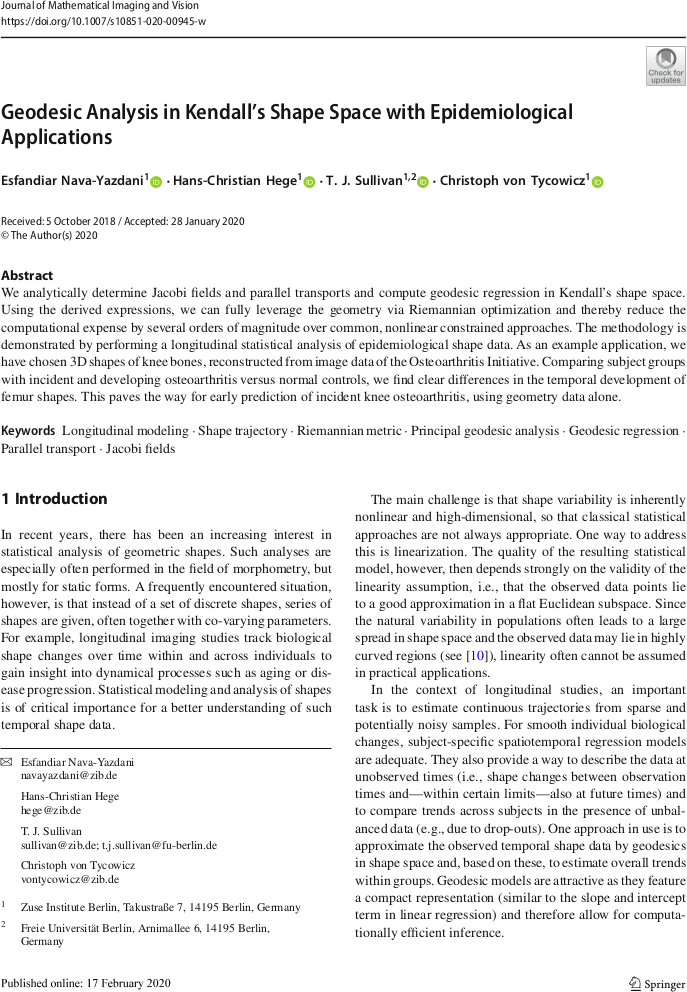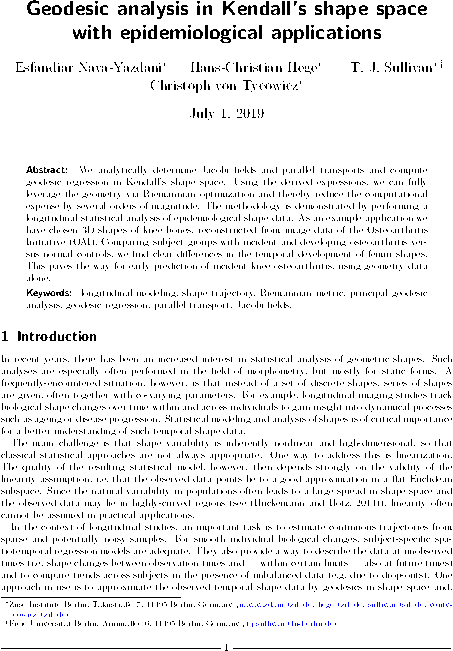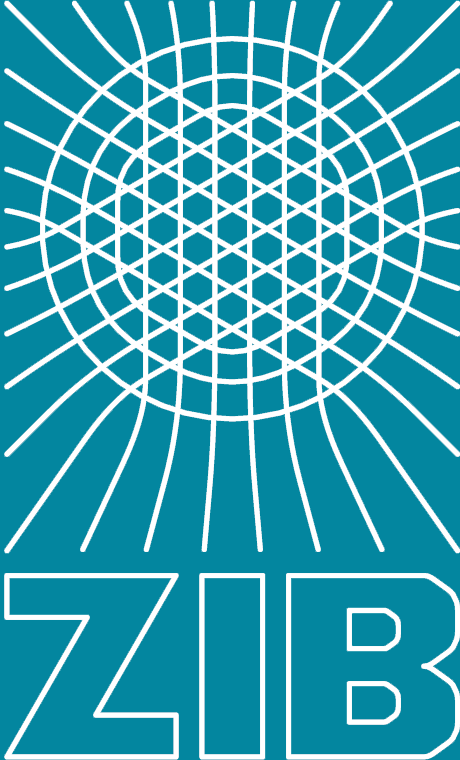#shape-trajectories

Geodesic analysis in Kendall's shape space now in J. Math. Imaging Vis.
The article “Geodesic analysis in Kendall's shape space with epidemiological applications” by Esfandiar Nava-Yazdani, Christoph von Tycowicz, Christian Hege, and myself has just appeared online in the Journal of Mathematical Imaging and Vision.
E. Nava-Yazdani, H.-C. Hege, T. J. Sullivan, and C. von Tycowicz. “Geodesic analysis in Kendall's shape space with epidemiological applications.” Journal of Mathematical Imaging and Vision 62(4):549–559, 2020.
Abstract. We analytically determine Jacobi fields and parallel transports and compute geodesic regression in Kendall’s shape space. Using the derived expressions, we can fully leverage the geometry via Riemannian optimization and thereby reduce the computational expense by several orders of magnitude over common, nonlinear constrained approaches. The methodology is demonstrated by performing a longitudinal statistical analysis of epidemiological shape data. As an example application, we have chosen 3D shapes of knee bones, reconstructed from image data of the Osteoarthritis Initiative. Comparing subject groups with incident and developing osteoarthritis versus normal controls, we find clear differences in the temporal development of femur shapes. This paves the way for early prediction of incident knee osteoarthritis, using geometry data alone.
Published on Tuesday 18 February 2020 at 14:00 UTC #publication #ch15 #shape-trajectories #nava-yazdani #von-tycowicz #hege

Geodesic analysis in Kendall’s shape space
Esfandiar Nava-Yazdani, Christoph von Tycowicz, Christian Hege, and I have just uploaded an updated preprint of our work “Geodesic analysis in Kendall's shape space with epidemiological applications” (previously entitled “A shape trajectories approach to longitudinal statistical analysis”) to the arXiv. This work is part of the ECMath / MATH+ project CH-15 “Analysis of Empirical Shape Trajectories”.
Abstract. We analytically determine Jacobi fields and parallel transports and compute geodesic regression in Kendall's shape space. Using the derived expressions, we can fully leverage the geometry via Riemannian optimization and thereby reduce the computational expense by several orders of magnitude. The methodology is demonstrated by performing a longitudinal statistical analysis of epidemiological shape data. As an example application we have chosen 3D shapes of knee bones, reconstructed from image data of the Osteoarthritis Initiative (OAI). Comparing subject groups with incident and developing osteoarthritis versus normal controls, we find clear differences in the temporal development of femur shapes. This paves the way for early prediction of incident knee osteoarthritis, using geometry data alone.
Published on Monday 1 July 2019 at 08:00 UTC #preprint #ch15 #shape-trajectories #nava-yazdani #von-tycowicz #hege
A Shape Trajectories Approach to Longitudinal Statistical Analysis
Esfandiar Nava-Yazdani, Christoph von Tycowicz, Christian Hege, and I have just published a preprint of our work “A Shape Trajectories Approach to Longitudinal Statistical Analysis”.
For Kendall's shape space we determine analytically Jacobi fields and parallel transport, and compute geodesic regression. Using the derived expressions, we can fully leverage the geometry via Riemannian optimization and reduce the computational expense by several orders of magnitude. The methodology is demonstrated by performing a longitudinal statistical analysis of epidemiological shape data.
As application example we have chosen 3D shapes of knee bones, reconstructed from image data of the Osteoarthritis Initiative. Comparing subject groups with incident and developing osteoarthritis versus normal controls, we find clear differences in the temporal development of femur shapes. This paves the way for early prediction of incident knee osteoarthritis, using geometry data only.
Published on Wednesday 1 August 2018 at 12:00 UTC #preprint #ch15 #shape-trajectories #nava-yazdani #von-tycowicz #hege

Esfandiar Nava-Yazdani Joins the UQ Group
It is a pleasure to announce that Esfandiar Nava-Yazdani will join the UQ and Visual Data Analysis research groups as a postdoctoral researcher with effect from 1 August 2017. He will be working on project CH15 “Analysis of Empirical Shape Trajectories” as part of the Einstein Center for Mathematics Berlin, co-led by Christian Hege, Christoph von Tycowicz and myself.
Published on Tuesday 1 August 2017 at 15:30 UTC #group #ch15 #shape-trajectories #nava-yazdani #hege #von-tycowicz